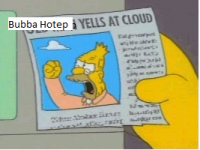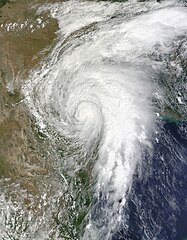#1103 Postby CaptinCrunch » Thu Jan 09, 2020 5:25 pm
Area Forecast Discussion
National Weather Service Fort Worth TX
212 PM CST Thu Jan 9 2020
.SHORT TERM...
/Tonight through Midnight Friday night/
The primary headline is that the numerical guidance has continued
to slow down the upper level low, deepen it more, and some models
are even showing an evolution into a negative tilt trough by
Friday night. Needless to say this trend is indicative of a more
dynamic system and results in the severe weather risk area being
pulled back farther to the west. At this point, we are comfortable
advertising a severe weather threat over the entire CWA, however
the greater risk will continue to be from roughly the I-35
corridor eastward into East Texas. All modes of severe weather
will be possible Friday afternoon and evening.
For tonight a warm/moist advection regime will prevail with
dewpoints continuing to creep upward. Clouds will also persist
and this will keep temperatures from cooling too much. Lows will
be in the low to mid 60s. While this should be above the record
high minimums for both DFW and Waco these will likely not hold
through all of Friday due to the arriving cold front.
(Of note: DFW broke a 120 year record high minimum of 53 with a
low of 58 this morning. And of even more note: that 53 is the
coldest high minimum record temp at DFW for any day. It`s
incredible DFW somehow dodged a warmer minimum temp 118 times
until today).
Otherwise a lead upper level disturbance is tracking over the
area this afternoon and will pull off to the northeast this
evening. Weak lift from this system will allow for the
continuation of showers over the eastern half of the area with
even a threat of some elevated isolated thunderstorms mainly in
the northeast zones this evening. Thus PoPs will be highest over
the east with no PoPs mentioned farther west and all will taper
down after midnight.
The upper level trough to our west will close off Friday and enter
the state during the afternoon hours. Strong dynamical forcing
will overspread the region well ahead of it and result in the
lifting of a weak cap by early afternoon. Although CIN will be
negligible with the cap gone, determining whether we will have
convective initiation out ahead of a cold front remains a huge
forecast challenge since there will be no level focus to help
"trigger" storms. Should vigorous convection develop in this
regime we will be particularly concerned about supercells and the
tornado potential given the high values of wind shear in place and
well organized cyclonically curving hodographs. The supercells
that form in these weakly-forced warm advection regimes out ahead
of the front are the ones responsible for our noteworthy cool
season tornado events (and some warm season events too). The setup
for this event certainly checks all the boxes for what we look
for in a cool season tornado outbreak, with perhaps the exception
of instability being just a little lower than the big events like
Dec 29th `06 and Dec 26th `15 (if you believe current model
forecasts). And so what keeps us from saying a tornado outbreak is
on the horizon is that there are countless unnamed and forgotten
events that look similar to this one which produced no tornadoes.
So I believe the key tomorrow will be the instability - reflected
by the dewpoint readings during the late morning and afternoon
hours. If upper 60s dewpoints can make it into the region and
temperatures can climb into the mid 70s, then it will likely be a
bad day for us. Until then the best we can say is that the severe
weather threat will begin in the early afternoon hours when some
of these cells MAY start to develop. These early supercells could
develop anywhere in North/Central Texas, but probably the eastern
half of the region is more favored due to the expected higher
moisture. They will be very fast moving, rocketing off to the
northeast at 50 mph, and given the expected low cloud cover,
visual spotting and tracking will be difficult.
By the late afternoon hours a north-south oriented "Pacific" cold
front will organize and intensify in our western zones and begin
to move rapidly east. With the addition of a well defined low
level "trigger" into the mix, strong dynamic forcing, and no
capping inversion, a line of severe thunderstorms will develop
along the front. Given the strong wind profiles this line will
likely result in a moderate threat of damaging winds and some
brief spin-up tornadoes. We believe the line will form around 4
pm near Hwy 281 and move eastward - affecting the I-35 corridor
between 5 pm and 9 pm, and the far eastern zones before midnight.
Not to be forgotten will be the threat for heavy rainfall. The
axis of highest rain (2-4 inches) is expected to be from the DFW
area and points northeast where the line will have its slowest
initial motion. Elsewhere about 1 inch is expected, except for the
far western zones where some will miss out altogether.
TR.92
&&
.LONG TERM...
/Saturday morning onward/
Following the passage of Friday`s thunderstorm event (see short-
term discussion), a strong Arctic cold front will pass through
North and Central Texas. Robust cold air advection behind the cold
front will allow temperatures to fall into the 30s across
virtually the entire CWA, with temperatures likely to fall to
below freezing west of a line from Bonham to Fort Worth to
Comanche. While the majority of the precipitation will have moved
off to the east of our CWA, light precipitation should develop on
the back side of the upper-level low in the deformation zone. The
GFS is the most aggressive with precipitation, with the NAM being
the most conservative. The ECMWF seems to lie between these two
extremes, and has also exhibited the most run-to-run consistency
with respect to the evolution of the synoptic pattern.
Going off of the ECMWF solution, the upper-level low should be
centered near or just north of the Red River by Saturday morning.
Strong ascent (seen on isentropic charts) will overspread the
region. There remains some question with regards to the amount of
moisture that will be available, but given that synoptic-scale
lift will be quite strong, and mid-level rates will be around 7
C/km, whatever little moisture that will exist should be able to
be "squeezed out". The result will be light, patchy precipitation
near and north of Interstate 20. Forecast soundings suggest that
snow or a rain/snow mix would be the most likely precipitation
type. Right now, accumulations (if any at all) would most likely
be light, and confined to grassy areas, rooftops, and other
elevated surfaces. One concern however is that with strong 850 mb
frontogenesis and steep mid-level lapse rates, there could be a
potential for localized bursts of heavier snow. If this were to
occur, it`s not entirely out of the question that some spots could
pick up a quick inch of snow. It should be stressed that this is
more of a reasonable high-end scenario, and is not either the most
likely scenario, nor is it something that most locations will
likely see. The most likely scenario for most locations along and
north of I-20 is brief, light snow, that barely accumulates if at
all. The probability of seeing accumulating snowfall will increase
the farther north one goes. Precipitation should come to an end
across the CWA by early Saturday afternoon.
With that out of the way, Sunday looks to be cold, but dry. A
modest warming trend will begin as we head into early next week.
Low chances for rain showers (and perhaps a few thunderstorms)
will return on Monday and continue into Tuesday as a warm air
advection regime establishes itself. Severe weather is not
expected.
On Wednesday, another strong cold front looks to move into the
region, bringing higher rain chances. There remains a significant
spread in the model guidance with how cold the air will be behind
this next cold front, so we will continue to show all rain for
now, but this mid to late next week storm system will be the next
event to watch.
1 likes
 The posts in this forum are NOT official forecast and should not be used as such. They are just the opinion of the poster and may or may not be backed by sound meteorological data. They are NOT endorsed by any professional institution or
The posts in this forum are NOT official forecast and should not be used as such. They are just the opinion of the poster and may or may not be backed by sound meteorological data. They are NOT endorsed by any professional institution or 
















